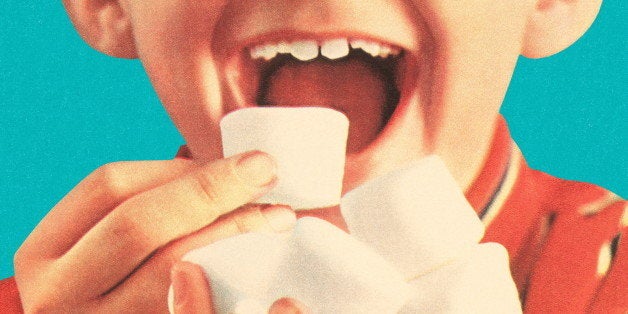
This much we agree on. "Reducing sugar intake is important for the health of our children both now and in the future," says professor Kevin Fenton, the national director of health and wellbeing at Public Health England (PHE). "We are all eating too much sugar and the impact this has on our health is evident."
Right on! Yet PHE almost completely misses the boat with its Change4Life campaign, which offers simple sugar-swapping tips including switching breakfast cereal for a lower-sugar option, changing regular sodas for diet sodas or fruit juice, and choosing "lite" or low-sugar snacks instead of high-sugar impact snacks. Let's briefly look at why each of these gets it wrong.
Swap cereal for a lower-sugar cereal
Every health-conscious parent who visits the cereal aisle knows most commercial breakfast cereals come loaded with sugar. Well aware you're looking for healthier alternatives, manufacturers enhance cereals with protein, fiber, whole grains, and "lower sugar" promises.
In his blog "Buyer Beware: Your Cereal May Contain More Sugar Than a Dessert!," Steve Hirsch, M.D., notes they might actually have more sugar than junk-food cereals. "Don't be fooled by these so-called healthy cereals," he says. "Read the nutritional labels first."
Even if cereals are lower sugar, remember that all carbohydrates convert to sugar in your body. "Healthier" cereals might still contain 30 or 40 grams of total carbohydrate per serving. According to Mark Hyman, M.D., in addition to 152 pounds of straight sugar, the average American eats 146 pounds of flour that converts to sugar every year.
The PHE recommends serving lower-sugar cereal "with skimmed or semi-skimmed milk to help lower their saturated fats intake too." Ironic, considering skim milk contains more lactose (sugar) than full-fat milk.
When you pull fat from dairy, you remove its flavor and satiety while increasing sugar load. Skim milk is also highly processed. The high heat used in making skim milk kills all the beneficial bacteria in it. And the skimming process not only strips the milk of essential healthy saturated fats and vitamins, but some manufacturers even add powdered non-fat milk.
So it's got none of the healthy fats you need for hormone synthesis, fewer of the vitamins and minerals essential for a high-functioning metabolism, and more lactose (sugar) than full-fat milk.
Skim milk on cereal essentially becomes sugar on top of sugar. How is this healthier for children?
Swap Regular Soda for Diet Soda or Fruit Juice
For decades experts remained baffled why zero-calorie sodas added up around our waistlines and studies showed folks who drank diet cola gained more weight than regular-soda drinkers.
One recent study suggested psychological reasons that increase caloric intake: "Those who drank the artificially sweetened drink were 2.93 times more likely to take the candy than those who had consumed either the sugary soda or the mineral water," writes Tom Jacobs.
Another 2014 study found artificial sweeteners -- prevalent in diet sodas -- altered gut bacteria, shedding new light about how they create health problems.
"Researchers found that artificial sweeteners changed the composition of gut bacteria over time, which could explain why subjects became more glucose intolerant over time," writes Anna Almendrala. "Prolonged glucose intolerance leads to conditions like obesity and diabetes -- the very things that people drinking diet sodas are trying to avoid."
In short, 2014 wasn't a good year for artificially sweetened diet sodas, and evidence continues to mount that they benefit neither your waistline nor your health. So why would PHE recommend them as a suitable substitute for children?
Equally misguided are the swap for fruit juices, which sometimes contain more sugar ounce-per-ounce than regular soda. The Change4Life admits "even unsweetened fruit juice is sugary," so why would they suggest it as a healthy soda alternative?
Swap High-Sugar Impact Snacks for "Lite" Snacks
"Lite" almost always becomes a signal for added sugar. Don't believe me? Compare a small container of full-fat Greek yogurt with a "lite" fruit-on-the-bottom yogurt. That "lite" container might have more sugar than a candy bar.
Beware of manufacturers' ever-savvy junk-food claims. "No sugar added" does not mean sugar-free, and oftentimes these snacks become sweetened with artificial sweeteners or excessive amounts of sugar alcohols.
Gluten-free has become the newest junk-food health halo, when these snacks can actually have as much if not more sugar than regular versions.
Mark Sisson compares the gluten-free junk-food boom to "the fat-free labeling craze, where you had fat-free cookies with twice the sugar, fat-free yogurt with thrice the sugar, fat-free salad dressing with whatever sorcery they incorporated to make that possible. And people ate those things with willful abandon, confident that 'fat-free' was a synonym for 'healthy' -- and obesity rates continued to rise."
Fortify it with fiber, remove the fat, replace some sugar with aspartame or maltitol, whatever -- a cookie is still a cookie, period.
Change4Life Didn't Get it Completely Wrong...
Much as I want to commend the move towards lower-sugar impact foods here, the PHE majorly misstepped with most of these recommendations. About the only thing I can commend here is giving children small amounts of whole fruit rather than sugary snacks. Any kid can learn to love the natural sweetness of an organic apple with almond butter.
With a little creativity and nutrition knowledge, we can create much better sugar swaps for our kids. Instead of diet sodas or fruit juice, make stevia-sweetened lemonade or flavor mineral water with lemon or lime. A low-sugar impact protein shake makes a fast, simple breakfast in about the time it takes to pour cereal and milk. Frozen blueberries with unsweetened Greek yogurt (if they aren't dairy intolerant) make a delicious, simple snack without the added sugar.
What smarter sugar swap would you add to this list? Do you feel the PHE's recommendations got it mostly correct or wrong? Share your thoughts below.